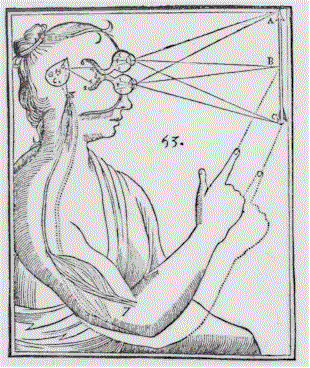Although there has yet be a general concurrence as to what the essence of the relationship between the mind and body is, it is reasonable to assume that the physicochemical properties of the brain drive physical processes of the body. It still remains unclear as to how these neural states achieve meaning and intentionality.
The mind-body problem is defined as the problem of an immaterial mind influencing a material body. Rene Descartes was one of the first philosophers to address this problem. His approach to the mind-body problem is known as Cartesian substance dualism. His theory contains three major points. First, there are two different kinds of substances within the world: mental and material. A mind is classified as a mental substance and its role is to think and maintain consciousness. A body is classified as a material substance whose sole reason for existence is spatial extension. Second, a human is composed of two things: a mind and a body. Third, the mind is different from the body and there can never be a mind identical to a body. Essentially, the mind and body causally influence each other.
According to Descartes, the entire body did not immediately affect the mind, but rather only one small part of the brain (i.e. the pineal gland) presented certain signals to the mind in  accordance with a given situation. How can an immaterial substance directly affect this small gland? Princess Elisabeth of Bohemia, a pupil of Descartes, refuted his theory by explaining that the pushing of the thing being moved produces any and all movement. That is to say, contact is required in order to move a body and spatial extension is required to make contact with a material substance. These two qualities are lacking in regards to a mind or any immaterial substance; in fact, the absence of these qualities defines an immaterial substance.
accordance with a given situation. How can an immaterial substance directly affect this small gland? Princess Elisabeth of Bohemia, a pupil of Descartes, refuted his theory by explaining that the pushing of the thing being moved produces any and all movement. That is to say, contact is required in order to move a body and spatial extension is required to make contact with a material substance. These two qualities are lacking in regards to a mind or any immaterial substance; in fact, the absence of these qualities defines an immaterial substance.
So what causes human behavior? It is widely accepted that behavior is closely related to mentality. A person’s actions are integrally connected to that person’s thoughts, feelings and intended accomplishments. However, the essence of the relationship is yet to be defined. Philosophical behaviorism addresses this issue by claiming that behavior establishes the existence of mentality. That is to say, the mind is merely a matter of having the capacity to exhibit behavior. A behaviorist believes that any psychological sentence can be broken down to behaviors that include no inner psychological manifestations. This can be further developed to say that every psychological expression can be explained in terms of strictly behavioral and physical manifestations without any loss of content.
Is it reasonable to assume that all psychological manifestations can be defined strictly through behavior? Let us consider advanced cognitive states such as beliefs. It makes little sense to believe there is a characterized behavior for someone’s political opinions. This brings about the concept of verbal behavior. Verbal behavior is the idea that a person will respond verbally in accordance to being prompted in various ways. In order for verbal behavior to be considered, one would have to understand a given language and be able create and understand sentences using said language. Assuming that person was verbally competent, it is impossible to know whether or not that person would be telling the truth. However, behavior is an undeniable epistemological influence on mentality and is the foundation for social interaction.
If the brain is more complex than observable human behavior, the brain could arguably be the mind. Kim explains that a lightning bolt is no more than an atmospheric electrical discharge, similarly to mental events being no more than the neural processes in the brain. Although both examples differ in the words used, they still refer to the same phenomenon. For example, pain is equivalent to C-fiber excitations despite them being worded differently. This brings up the multiple realization argument which explains that not all organisms have the same biological makeup but can still exhibit behaviors that, although different to humans still refer to the same psychological manifestation. If any mental state is multiply realizable by various physical responses, then it cannot be identical to any specific physical manifestation.
If each mind is different, could it be that mental states are defined by their role as part of a system of mental states? Machine functionalism defines the mind as a Turing machine. Kim refers to the Turing machine as a probabilistic automaton that calculates the probability of certain events occurring. Mentality is actualized through the brain being a physical computer that realizes an appropriately complex Turing machine. Searle believes that machine functionalism is an incorrect account of human thinking and that meaning can only be achieved in biological brains. Searle notes that a computer may be able to reach the same conclusion as a human but it could not understand the meaning behind said conclusion. If biological conditions in the brain drive neural processes, then what causes those neural states to achieve meaning? Kim explains that the only thing we can be confident about at this point is that contact with the real world is necessary in order to achieve meaning, understanding, and other cognitive functions. Any further developed theory is merely speculation.
